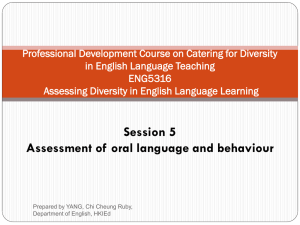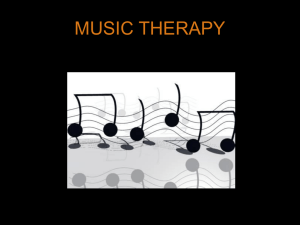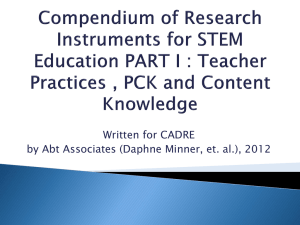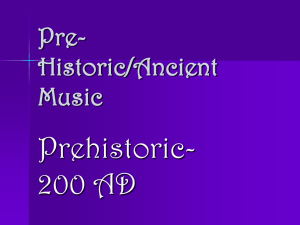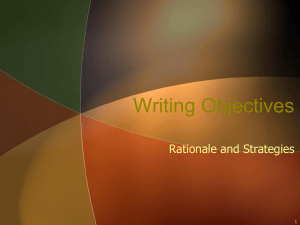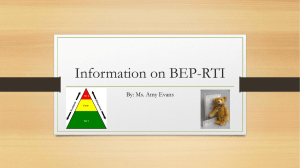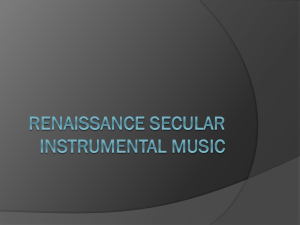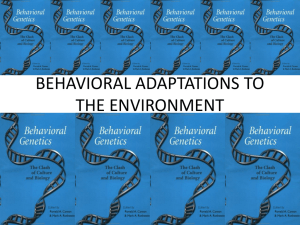AM_Finalpowerpoint
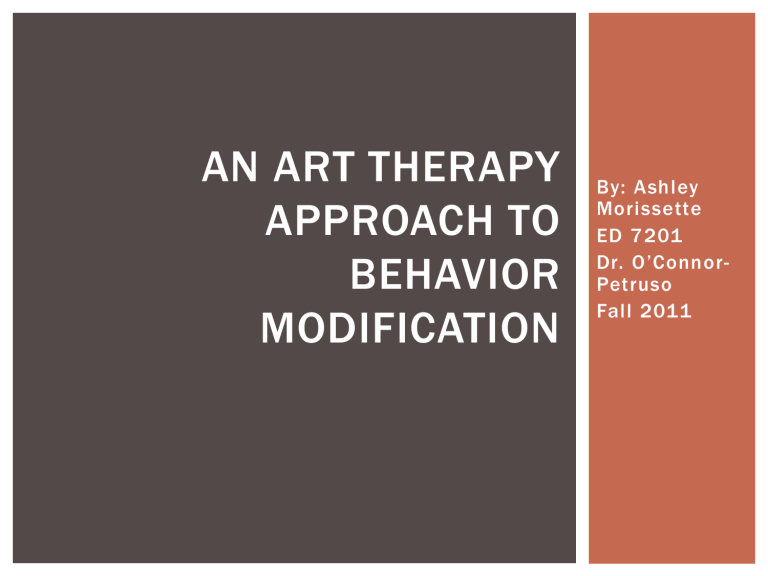
AN ART THERAPY
APPROACH TO
BEHAVIOR
MODIFICATION
By: Ashley
Morissette
ED 7201
Dr. O’Connor-
Petruso
Fall 2011
TABLE OF CONTENTS
Introduction
Why Art Therapy?
Pros and Cons
Statement of the Problem
Review of Related Literature
Current Instructional Strategies
Participants
Instruments
Hypothesis
References
INTRODUCTION
Art therapy is a growing field and has gained wide acceptance as a modality that uses the nonverbal language of art for personal growth , insight and transformation .
(Malchiodi,2007)
Art therapy has been used as a medium to assist students with special needs, physical and mental disabilities and students with behavioral problems such as ADHD and
ODD.
WHY ART THERAPY?
Art therapy uses the creative process to help individuals:
resolve conflicts and problems
develop sense of self (Nisenson, 2008)
manage behavior
create new patterns of learning (Nisenson, 2008)
increase self-esteem and awareness
STATEMENT OF THE PROBLEM
Special education students with behavioral problems have trouble staying focused and on track.
Behavioral management distracts from valuable instruction time.
Some classroom environments do not nurture special education students needs.
Majority of the subjects taught throughout the day tap into logical thinking skills and not enough time is spent on their senses and imagination.
Art serves as a vehicle for developmental learning and can impacts the spirit and emotional response of a child.
Arts instruction is a catalyst for creative expression, social development and can aid in problem solving.
Budget cuts have caused very little to no arts instruction.
REVIEW OF RELATED LITERATURE
Research indicates that the majority of children with emotional difficulties also have learning disabilities
(Freilich & Shectman, 2010).
Play and artistic expression are commonly used in therapeutic and educational settings (Bagilishya,
Drapeau, Heusch, Lacroix, & Rousseau, 2005).
Many studies (Adu-Agyem, 2009; Bagilishya et al.,
2005; Dorff & Pochedley, 2008; Dunn-Snow, 1999;
Naumburg, 2001) have investigated the link between art making in the classroom setting and increased self esteem.
REVIEW OF RELATED LITERATURE
Art therapy practices facilitate in connecting children’s expression of emotion and serve as a vehicle for non-verbal communication (Adu-
Agyem, 2009; Mason, Steedy, & Thorman, 2008)
Art and music therapy are a mirror into the personality. (Nisenson, 2008)
Children whose emotional health is strained can benefit from art therapy through the intervention of play work and creative arts. (Dunn-Snow,
1999; (Frost, 2005)
REVIEW OF RELATED LITERATURE
(CONT’D)
It is critical for all students, including those who are atypically developing such as those with autism, to have access to an art experience at school.( Furniss, 2009;
Buenaflor, 2008)
Art therapy as a component to social skills training may increase the willingness of children to participate because art is an activity that they find acceptable. ( Epp,
2008; Naumburg, 2001)
Art therapy allows children to solve problems visually and offers a non-threatening way to deal with rejection.
(Freilich, R., & Shectman, Z., 2010)
REVIEW OF RELATED LITERATURE
(CONT’D)
Art has the potential to assist special needs children in communicating with others and to obtain confidence in their own ideas. (Balke, 1997; Germain, 2008)
By allowing students more freedom and accountability when making art in the classroom, teachers can promote self-worth as an artist and foster self-esteem at the same time. (Rufo, 2011; Viza, 2005; Taylor, 2005 )
Some of the most commonly mentioned benefits of art therapy are self-esteem, self-expression, problem solving, and conflict resolution (Bagilishya et al., 2005).
SAMPLE ART INTEGRATED MATH
ACTIVITIES
SAMPLE ART INTEGRATED MATH
ACTIVITIES
SAMPLE ART INTEGRATED MATH
ACTIVITIES
PARTICIPANTS
A group of students from P.S. X- a lowincome urban school in East New York, Brooklyn.
The population is 43% African American, 25%
Asian and 21% Hispanic. The participants will be first-grade students who have demonstrated a lack of focus , behavioral problems , and/or underdeveloped social skills.
INSTRUMENTS: APPENDIX D
D ear Par ent /Guardian,
I am c urrently a g r aduate st udent i n Bro oklyn C o l lege’s C hi l dhood E ducation
M aster ’s pro gram. I am c o nducting a r esearc h st udy o n t he benefits o f i nfusing ar t r el ated ac t ivities i nto M at h l esso ns, i n o r der to i nc r ease t he st udents’ o n -t ask behav i or. I am r equest ing yo ur per mission to use yo ur c hi ld’s dat a fo r my r esearc h st udy. A l l i nst ruction w i ll t ake pl ac e i n yo ur c hi ld’s r eg ular c l assroom and t hey w i ll be r ec eiving t he sam e o bjectives as t he r est o f t he c l ass. T hi s st udy w i ll al so al l ow yo ur c hi ld to g ai n ex posure to ar t s i nst ruction.
A l l r esults fo r t hi s st udy w i ll be r epo r ted as a g ro up st udy and t her efore, t he par t icipant’s nam es and i nformation w i ll be ano ny mous. I g r eatly appr eciate yo ur suppor t.
S i ncerely,
A shl ey M o r issette
I g i ve my c hi ld__________________________________________ per mission to be a par t icipant i n t hi s r esearc h st udy.
Par ent ’s S i g nature:___________________________________
D ate:____________________
INSTRUMENTS: APPENDIX D
Sample of
Behavioral
Checklist
INSTRUMENTS: APPENDIX B
D ear _ _ _ _________________,
I am c urrently a g r aduate st udent i n Bro oklyn C o l lege’s C hi l dhood E ducation
M aster ’s pro gram. I am c o nducting a r esearc h st udy o n t he benefits o f i nfusing ar t r el ated ac t ivities i nto M at h l esso ns, i n o r der to i nc r ease t he st udents’ o n -t ask behav i or. I am r equest ing yo ur per mission to use yo ur st udent’s dat a fo r my r esearc h st udy. I w i ll i nfuse ar t -i ntegrated t asks i nto yo ur ex i sting l esso n pl ans dur ing t he m at h bl oc k of your day. Inst r uction w i ll t ake pl ace 3 t i mes a week , over a 6 -week per i od. A l l i nst ruction w i ll t ake pl ace i n yo ur c l assroom and t he st udents w i ll be r ec eiving t he sam e o bjectives as t he r est o f t he c l ass. I w i ll m easure st udents’ pro gress by r equesting yo ur par t icipation i n a quest ionnaire r eg ar ding st udents’ behav i or s, pr e and po st i nter vention.
A l l r esults fo r t hi s st udy w i ll be r epo r ted as a g ro up st udy and t her efore, t he par t icipant’s nam es and i nformation w i ll be ano ny mous. I g r eatly appr eciate yo ur suppor t. If you have any quest ions pl ease feel fr ee to c ontact me.
A shl ey.morissette@gmail.com
o r 3 0 5 .4 39.76 22.
S i ncerely,
A shl ey M o r issette
I, _ _ ________________________________________ g i ve my per mission to be a par t icipant i n t hi s r esearc h st udy.
Teac her’s S i gnature:___________________________________
D ate:____________________
INSTRUMENTS: APPENDIX C
D e a r P r i n c i p a l _ _ _ _ _ _ _ _ _ _ _ _ _ _ _ _ _ _ _ _ _ ,
I a m c u r r e n t l y a g r a d u a t e s t u d e n t i n B r o o k l y n C o l l e g e ’ s C h i l d h o o d E d u c a t i o n M a s t e r ’ s p r o g r a m . I a m c o n d u c t i n g a r e s e a r c h s t u d y o n t h e b e n e f i t s o f i n f u s i n g a r t r e l a t e d a c t i v i t i e s i n to
M a t h l e s s o n s , i n o r d e r to i n c r e a s e t h e s t u d e n t s ’ o n - t a s k b e h a v i o r. T h i s s t u d y r e q u i r e s a n i n t e r v e n t i o n to b e i m p l e m e n t e d i n a r e a l c l a s s r o o m s e t t i n g . I a m r e q u e s t i n g yo u r p e r m i s s i o n to u s e s e l e c t f i r s t g r a d e s t u d e n t ’ s d a t a f o r my r e s e a r c h s t u d y. I w i l l i n f u s e a r t - i n t e g r a t e d t a s k s i n to t h e t e a c h e r ’ s e x i s t i n g l e s s o n p l a n s d u r i n g t h e m a t h b l o c k o f t h e d ay. I n s t r u c t i o n w i l l t a k e p l a c e 3 t i m e s a w e e k , o v e r a 6 - w e e k p e r i o d . A l l i n s t r u c t i o n w i l l t a k e p l a c e i n t h e c h i l d ’ s r e g u l a r c l a s s r o o m a n d t h e s t u d e n t s w i l l b e r e c e i v i n g t h e s a m e o b j e c t i v e s a s t h e r e s t o f t h e c l a s s . I w i l l m e a s u r e s t u d e n t s ’ p r o g r e s s b y r e q u e s t i n g t h e t e a c h e r ’ s p a r t i c i p a t i o n i n a q u e s t i o n n a i r e r e g a r d i n g s t u d e n t s ’ b e h a v i o r s , p r e a n d p o s t i n t e r v e n t i o n .
A l l r e s u l t s f o r t h i s s t u d y w i l l b e r e p o r t e d a s a g r o u p s t u d y a n d t h e r e f o r e , t h e p a r t i c i p a n t ’ s n a m e s a n d i n f o r m a t i o n w i l l b e a n o ny m o u s . I g r e a t l y a p p r e c i a te yo u r s u p p o r t . I f yo u h a v e a ny q u e s t i o n s p l e a s e f e e l f r e e to c o n t a c t m e . A s h l ey. m o r i s s e t t e @ g m a i l . c o m o r 3 0 5 . 4 3 9 . 76 2 2 .
S i n c e r e l y,
A s h l ey M o r i s s e t t e
I , _ _ _ _ _ _ _ _ _ _ _ _ _ _ _ _ _ _ _ _ _ _ _ _ _ _ _ _ _ _ _ _ _ _ _ _ _ _ _ _ _ _ g i v e my p e r m i s s i o n to b e a p a r t i c i p a n t i n t h i s r e s e a r c h s t u d y.
P r i n c i p a l ’ s S i g n a t u r e : _ _ _ _ _ _ _ _ _ _ _ _ _ _ _ _ _ _ _ _ _ _ _ _ _ _ _ _ _ _ _ _ _ _ _ D a t e : _ _ _ _ _ _ _ _ _ _ _ _ _ _ _ _ _ _ _ _
HYPOTHESIS
HR1: By implementing art therapy practices to
15 first-grade students at PS X in Brooklyn, NY for 45 minutes a day, 3 days a week, over a 6week period, students’ on-task behavior and positive social skills will increase.
REFERENCES
Adu - A gyem, J. (2 0 0 9 ) E nhanc ing c hildr en's l ear ni ng: T he ar t per spective.
I n ternational J ou r n al of E d u cation t h r ough Ar t , (5 ) 2 3 , 14 3 -1 55.
Bag ilishya , D ., D r apeau, A ., Heusc h , N ., Lac roix , L. & Ro usseau, C . (2 0 0 5 ).
E val uation o f a c l assroom pro gram o f c r eative ex pression wo rkshops fo r r efugee and i m migr ant c hi ldren. J ou r nal of Ch ild P s ychology & P s yc hiatr y, 4 6
(2 ) 1 8 0 -1 85 . do i: 10 .1 1 11/j.14 69 -7610 .20 04.003 44. x
Bal ke , E. (1 9 97 ). Pl ay and t he ar t s: T he i mpor tance of t he “unimpor tant.”
C h ild hood E d u c ation, 7 3 (6 ), 3 5 5 .
Buenaflor, J. (2 0 0 8 ). D o es i nc luding ar t m ake a di f ference? Mom entum, 3 9 (2 ), 8 -9 .
D er by, J. (2 01 1 ) D i sability st udies and ar t educ ation. S t u dies in Ar t E d u c ation: A
J ou r nal of I s sues a n d Res earch, (5 2 )3 , 9 4 -1 11 .
D o r f f, J. & Po c hedley, E . (2 0 0 8 ). T he power o f c o llaboration: Two teac her s wo rking to get her fo r t hei r st udents’ suc cess. D elt a Ka p pa G a mma Bu lletin,
7 5 (1 ), 1 8 -2 2 .
D unn-Snow, P. (1 9 9 9). A sc hool i nc lusion approac h: E valuating em bedded assessm ent w i thin t he c o ntext o f m ul ticultural g ro up ar t ex periences. D elt a
Ka p pa G a mma Bu lletin . 6 6 (1 ), 41 -5 0.
Epp , K.M . (2 0 0 8 ). Out come -based eval uation of a soc ial ski lls prog ram usi ng ar t t her apy and g ro up t her apy fo r c hildren o n t he aut i sm spec trum. Ch ild ren
& S c h ools, 3 0 (1 ), 27 -3 6.
REFERENCES
Fr ei lich , R., & S hec t man , Z. (2 010 ). T he c ontribution of ar t t her apy to t he so c ial , em otional, and ac ademic adj ustment o f c hi ldren w i th l ear ning di sabilities . T h e Ar t s in P s yc hother apy, 37 (2 010), 97 -10 5.
Fro st , J.L. (2 0 0 5 ). Lesso ns fro m di saster s: Pl ay, wo rk , and t he c r eat ive ar t s.
Ch ild hood E d u c ation , 8 2 (1 ), 2 -8 .
Fur niss , G.J. (2 0 0 8 ). C el ebrating t he ar t making o f c hi ldren w i th aut ism. Ar t
Ed ucation , 61 (5 ), 8 -1 2 .
Ger m ain , C . (2 0 0 8). A r t fo r spec ial needs st udents: Bui lding a phi losophical fr am ework . Ar t s & Ac t ivit ies , 14 3 (3 ) 5 5 ,71 .
Henl ey, D . (1 9 9 8 a) . Fac ilitating so c ializ ation w i thin a t her apeutic c am p set t i ng fo r c hi ldren w i t h at tent ion defi cits ut i lizing t he ex pressive t her apies. Am eric an
J ou r nal of Ar t T h er apy , 3 8 (2 ), 4 0 -5 0 .
Henl ey, D . (1 9 9 8 b) . A r t t her apy i n a so c ialization pro gram fo r c hildren w i th at tent ion deficit hy peractivity di sorder . Amer ican Jour nal of Ar t Ther apy , 37
(1 ), 2 -1 1 .
M aso n, C ., S teedly, K . & T ho rman , M . (2 0 0 8 ). Im pact o f ar t s i nteg ration o n vo ice, c ho ice, and ac c ess. Tea c h er E d u cation & S p ec ial E d u cation 31 (1 ), 3 6 -4 6.
Naum burg , M . (2 0 01 ). S po ntaneous ar t i n educ ation and psyc hotherapy. Am erican
J ou r nal of Ar t T h er apy, 4 0 (1 ) 47 -6 4.
Ni senson , K. (2 0 0 8 ). A r t s for heal i ng: T he i mpor tance of i nteg rated music and ar t i n t her apy and spec ial educ ation. E xc eptional P a r ent, 3 8 (3 ), 4 2 -4 4.
REFERENCES
Osborne, J. (2 0 0 3 ). A r t and t he c hild w i th aut i sm: T her apy or educ ation? Ea r ly Child
D evelopment a n d C a r e, 17 3 (4 ), 41 1 -42 3.
Pac e, D ., S c hwar tz , D . (2 0 0 8 ). S t udent s c r eate ar t . Tea c h ing E xc eptional Ch ildren,
4 0 (4 ), 5 0 -5 4.
Rufo, D . (2 01 1 ). A l lowing ar t i stic ag enc y i n t he el em entar y c l assroom. Ar t
E d u c ation 6 4 (3 ), 1 8 -2 3 .
S i eg esmund , R. (2 0 0 2 ). Br i nging ac c o untability to el em entar y ar t . Ka p pa D elt a P i,
3 9 (1 ), 24 -2 8.
Tay lor, M . (2 0 0 5 ). S el f -identity and t he ar t s education o f di sabled yo ung peo ple.
D is a bility & S oc iet y, 2 0 (7 ), 76 3 -77 8.
U l man , E . (1 9 9 2 ). A r t education fo r t he em otionally di sturbed. Am erican J ou r nal of
Ar t Ther apy, 3 0 (3 ), 101 .
Vi z e , A . (2 0 0 5). M aki ng ar t ac t i vities wo rk fo r st udents w i t h spec ial needs. Ar t s &
Ac t ivities, 1 3 8 (4 ), 17 -41 .
Wal l er, D . (2 0 0 6 ). A r t t her apy fo r c hi ldren: How i t l eads to c hang e. Clin ic al Ch ild
P s yc hology P s ych iatr y, 11 (2 ), 271 -282 . do i : 10 .1 177 / 1 3 59104 5060 61419


